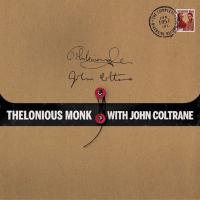Thelonious Monk With John Coltrane Complete 1957 Riverside Recordings (Mastering Info Update)
Coltrane acknowledged Monk’s strong influence on him in a 1960 Downbeat interview quoted in those original liner notes. So while this deluxe, imaginatively packaged 3 LP set, the first from Craft Recordings—a new label from Concord Bicycle Music—does “stretch” to fill three records with a false start of “Monk’s Mood”, multiple takes of “Crepuscule with Nellie” (five in all) and even one track on which Monk famously doesn’t play, these are the only studio recordings Monk made with Coltrane during the period where Coltrane “bloomed”.
That one Monk-less track, “Blues For Tomorrow", featuring Coleman Hawkins, John Coltrane and Gig Gryce with Art Blakey on drums, Wilbur Ware on bass and Ray Copeland on trumpet was recorded June 25th, 1957 after a frustrated Monk walked out of the studio. Producer Orrin Keepnews, eager to get something useable from the session had Gryce organize the blues number, presented here in stereo for the first time.
Of course Monk and Coltrane performed live nightly at the Five Spot Café in New York between April and July of 1957, so it’s not as if these are exploratory “get acquainted” sessions—far from it. Though the core of the set are the quartet tracks “Ruby My Dear”,“Trinkle, Tinkle”and “Nutty” (Coltrane, Monk, Ware and “Shadow” Wilson on drums), all of this material will be of interest to Monk and Coltrane fans.
While a CD version of this was released in 2006, this edition is newly re-mastered “from the original analog sources” by veteran cutting engineer George Horn and Anne-Marie Suenram and plated and pressed at RTI.
Realistically, a compilation like this was probably transferred track by track to high resolution digital (it will also be released as high rez files) because between splicing together the tracks and having the azimuth shift on each, and duping each track to assemble running masters, presents two less than ideal options.
What matters is the final sound, and in a word it’s “spectacular”: spacious, three-dimensional and especially transparent. These are early, mostly stereo recordings and like most such recordings have their sonic pluses and minuses, but here they are mostly in the plus column. If in fact the set was cut from tape, this review will be amended. Here's the amendment: Joe Tarantino mastered the tracks to 192/24 bit files, which were used to cut lacquers by George Horn. That's why it sounds so great.
Add Keepnews’ original eyewitness notes from the 2006 set, new artwork and great photos in a full sized booklet plus unique “file folder” presentation, this is a set fans of these two greats will want to own and enjoy.


